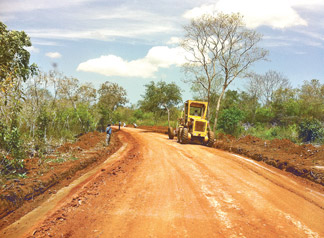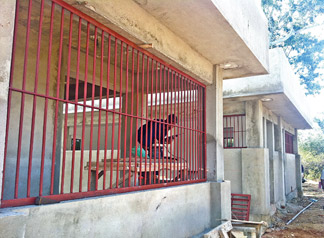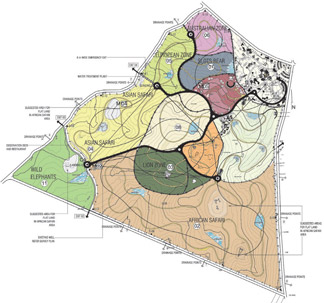Safari parks for endemic species
By Dhaneshi Yatawara
|

Road to the safari park under construction
|
Spread across 65,610 square kilometers Sri Lanka is one of the most
attractive countries with a rich bio-diversity. Sri Lanka has been
declared as one of the world’s 25 different hotspots for biodiversity.
Yet we shoulder a heavy responsibility of protecting endemic and the
endangered species. Today Sri Lanka is known to have the highest species
density in South Asia for flowering plants, amphibians, reptiles and
mammals while having the second highest human population density.
The species diversity of Sri Lanka shows 4000 species of flowering
plants, 107 species of freshwater fish, 59 species of amphibians, 174
species of reptiles, 435 species of birds, 140 species of mammals and
several thousand invertebrates, according to research.
Among fauna and flora of Sri Lanka 41% of fish, 65% amphibians, 52%
reptiles, 10% birds, 5% mammals, 80% land snails, all fresh water crabs
and 28% of flowering plants are endemic. Sri Lanka’s biodiversity
supports its economic development, specially tourism industry. Sri Lanka
has some of the best wild life reserves next to the African safari parks
where a visitor could see number of wild animals freely roaming in their
natural habitats. For example the elephant which can be seen in a
considerable numbers in the wild.
This high diversity of the animal kingdom also a valuable gene pool.
Conserving the gene pool in its natural habitat is ‘in situ’
conservation. That is conservation outside is known as ‘ex situ’
conservation.
Zoological gardens play a major role in ex-situ conservation.
The Zoological Garden in Dehiwala conserves a large number of endemic
and endangered species.
Two safari parks will be set up in Pinnawala and Hambantota as
conservation centres for endemic and endangered species. Director,
Department of National Zoological Gardens Bashwara Gunaratne said this
will not only be restricted to Sri Lankan fauna.
|

Leopard dens |
The Zoo will shelter as much as possible animals which are threatened
or endangered globally. The leopard enclosure is a vital factor of the
park.
“So many tourists come here to see leopards and many spend days in
jungles.
“A safari park is the best place to see such animals,” Zoological
Gardens Director Gunaratne said.
While caring for 13 leopards at the Dehiwela zoo (including the three
female cubs), the Department of Zoological Gardens is launching a
long-term plan to conserve endemic and endangered species. “Sri Lanka is
well-known across the globe as one of the best places to watch leopards
roaming freely,” said Gunarathne. Under the project, two zones will be
built at Pinnawala and Hambantota.
“This will be the conservation centre for endemic and endangered
species. Building the leopard enclosure is the first step in the drive
and we are planning to provide more facilities for sloth bear, African
wild animals and Antarctic region animals.
|

The plan of the Hambantota park |
The facility at Pinnawala Elephant Orphanage spreads over 12,267
square meters. The authorities hope to complete the project by April
2012. The architectural and engineering expertise is from the State
Engineering Corporation; Rs. 43.9 million will be spent on the project.
“It would allow visitors to see leopards freely.
We are constructing two viewing decks which will include restaurants
and souvenir shops. One viewing deck will have an underground restaurant
which too will give visitors a different view of the leopards,”
Gunarathne explained.
Structures built with timber for the leopards to climb along with big
trees.
They also propose in the plan to link the two viewing decks with a
bridge through the trees giving an better view for the visitor.
“At the moment we have planned to house about five – six leopards.
Naturally with one male leopard we can keep several female animals,” he
explained. A small tank is also under construction.
The Hambantota safari park is under construction at Ridiyagama which
spans 500 acres. Out of this 40 acres will be for the leopard enclosure.
The project is estimated to cost Rs. 2,000 million.
There will be education and awareness programs for visitors at the
viewing decks. The souvenir shops will also include items to promote
conservation. There will be separate monitoring program with CCTV
installed. We will not be obstructing the free movement of the animals.
“If there is CCTV monitors around the clock we can even let the animals
be out in the night,” Dr. Ganga Wijesinghe Veterinarian of the
Zoological Gardens said.
Shelters will be built for leopards.
|

